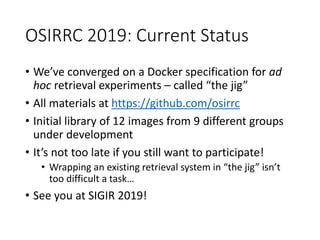The document provides an overview of the NTCIR-14 CENTRE Task, which aims to examine the replicability and reproducibility of results from past CLEF, NTCIR, and TREC evaluations. It describes the task specifications, including the replicability and reproducibility subtasks that asked participants to replicate or reproduce past run pairs. It also discusses the additional relevance assessments that were collected and the evaluation measures used, such as root mean squared error and effect ratio. The only participating team was able to mostly replicate the effects observed in the original NTCIR runs for the replicability subtask.



![Research questions
• Can results from CLEF, NTCIR, and TREC be
replicated/reproduced easily? If not, what are the
difficulties? What needs to be improved?
• Can results from (say) TREC be reproduced with
(say) NTCIR data? Why or why not?
• [Participants may have their own research
questions]](https://image.slidesharecdn.com/centreatntcir-14overview-190618003726/85/ntcir14centre-overview-4-320.jpg)


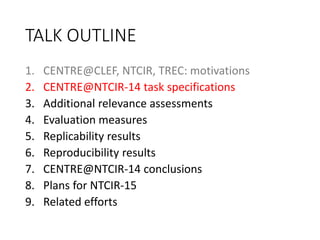




![Target NTCIR runs and data
for T1 (replicability)
• Test collection:
NTCIR-13 WWW English (clueweb12-B13, 100 topics)
• Target NTCIR run pairs:
From the NTCIR-13 WWW RMIT paper [Gallagher+17]
http://research.nii.ac.jp/ntcir/workshop/OnlineProceedings13/pdf/ntcir/02-NTCIR13-WWW-GallagherL.pdf
A: RMIT-E-NU-Own-1 (sequential dependency model: SDM)
B: RMIT-E-NU-Own-3 (full dependency model: FDM)
• SDM and FDM are from [Metzler+Croft SIGIR05]
https://doi.org/10.1145/1076034.1076115](https://image.slidesharecdn.com/centreatntcir-14overview-190618003726/85/ntcir14centre-overview-12-320.jpg)
![Target TREC runs and data
for T2 (reproduciblity)
• Test collection:
TREC 2013 Web Track (clueweb12 category A, 50 topics)
• Target TREC run pairs:
From the TREC 2013 Web Track U Delaware paper [Yang+13] :
https://trec.nist.gov/pubs/trec22/papers/udel_fang-web.pdf
A: UDInfolabWEB2 (selects semantically related terms using
Web-based working sets)
B: UDInfolabWEB1 (selects semantically related terms using
collection-based working sets)
• The working set construction method is from
[Fang+SIGIR06]
https://doi.org/10.1145/1148170.1148193](https://image.slidesharecdn.com/centreatntcir-14overview-190618003726/85/ntcir14centre-overview-13-320.jpg)
![How participants were expected to
submit T1 (replicability) runs
0. Obtain clueweb12-B13 (or the full data)
http://www.lemurproject.org/clueweb12.php/
and Indri https://www.lemurproject.org/indri/
1. Register to the CENTRE task and obtain the NTCIR-13 WWW
topics and qrels from the CENTRE organisers
2. Read the NTCIR-13 WWW RMIT paper [Gallagher+17]
http://research.nii.ac.jp/ntcir/workshop/OnlineProceedings13/pdf/ntcir/02-NTCIR13-WWW-GallagherL.pdf
and try to replicate the A-run and the B-run on the NTCIR-13
WWW-1 test collection
A: RMIT-E-NU-Own-1
B: RMIT-E-NU-Own-3
3. Submit the replicated runs by the deadline](https://image.slidesharecdn.com/centreatntcir-14overview-190618003726/85/ntcir14centre-overview-14-320.jpg)
![How participants were expected to
submit T2TREC (reproducibility) runs
0. Obtain clueweb12-B13 (or the full data)
http://www.lemurproject.org/clueweb12.php/
and (optionally) Indri https://www.lemurproject.org/indri/
1. Register to the CENTRE task and obtain the NTCIR-13 WWW topics and
qrels from the CENTRE organisers
2. Read the TREC 2013 Web Track U Delaware paper [Yang+13] :
https://trec.nist.gov/pubs/trec22/papers/udel_fang-web.pdf
and try to reproduce the A-run and the B-run on the NTCIR-13 WWW-1
test collection
A: UDInfolabWEB2
B: UDInfolabWEB1
3. Submit the reproduced runs by the deadline](https://image.slidesharecdn.com/centreatntcir-14overview-190618003726/85/ntcir14centre-overview-15-320.jpg)

![Submission instructions
• Each team can submit only one run pair per subtask
(T1, T2TREC, T2OPEN). So at most 6 runs in total.
• Run file format: same as WWW-1; see
http://www.thuir.cn/ntcirwww/ (Run Submissions
format). In short, it’s a TREC run file plus a SYSDESC
line.
• Run file names:
CENTRE1-<teamname>-<subtaskname>-[A,B]
Advanced Baseline](https://image.slidesharecdn.com/centreatntcir-14overview-190618003726/85/ntcir14centre-overview-17-320.jpg)



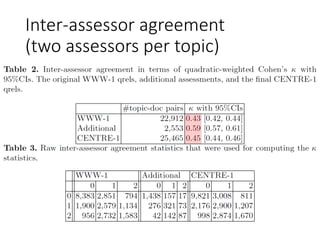




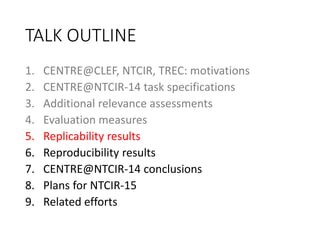

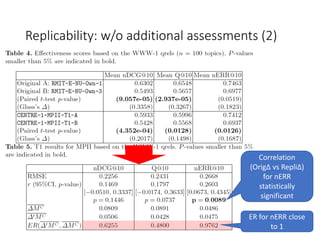

![nERR, r=0.2610, 95%CI[0.0680, 0.4351]
Orig Δ ≒ 0.4
Repli Δ ≒ 0.8
(A>B)
Orig Δ ≒ -0.3
Repli Δ ≒ -0.6
(A<B)
But replicability not so
successful at the topic level](https://image.slidesharecdn.com/centreatntcir-14overview-190618003726/85/ntcir14centre-overview-30-320.jpg)















![Task 1 & 2: Selected
Papers
For Task 1 - Replicability and Task 2 - Reproducibility we
selected the following papers from TREC Common
Core Track 2017 and 2018:
• [Grossman et al, 2017] Grossman, M. R., and
Cormack, G. V. (2017). MRG_UWaterloo and
Waterloo Cormack Participation in the TREC 2017
Common Core Track. In TREC 2017.
• [Benham et al, 2018] Benham, R., Gallagher, L.,
Mackenzie, J., Liu, B., Lu, X., Scholer, F., Moffat, A.,
and Culpepper, J. S. (2018). RMIT at the 2018 TREC
CORE Track. In TREC 2018.](https://image.slidesharecdn.com/centreatntcir-14overview-190618003726/85/ntcir14centre-overview-46-320.jpg)


